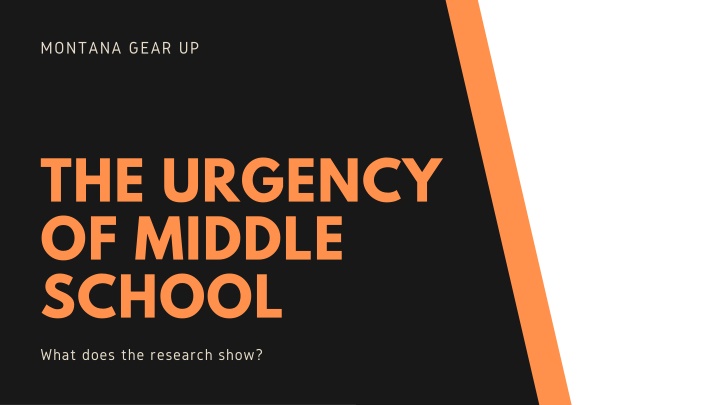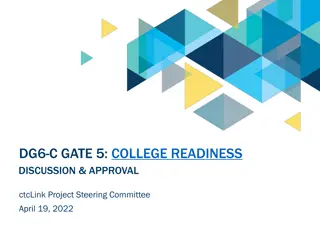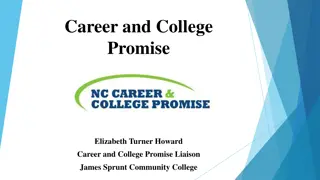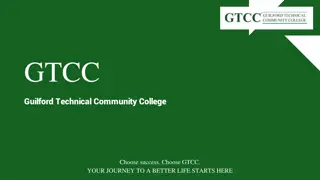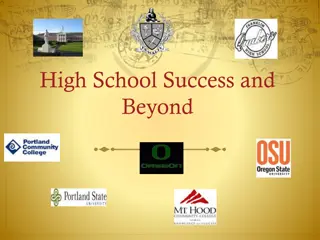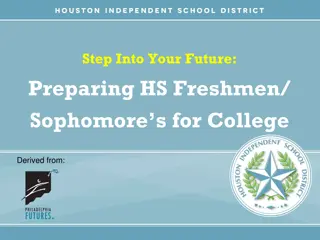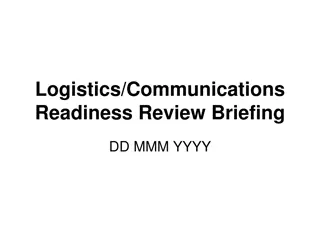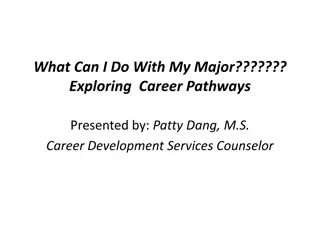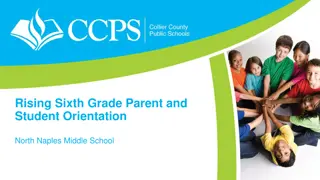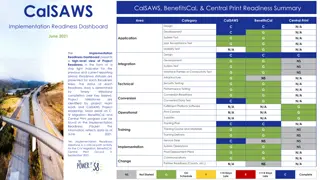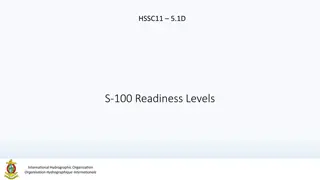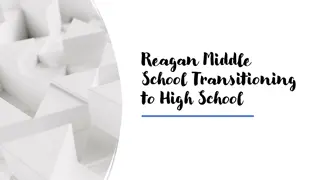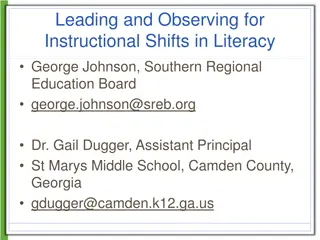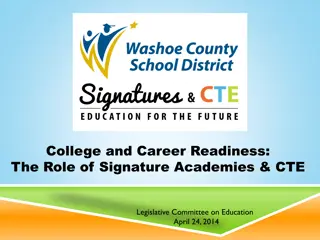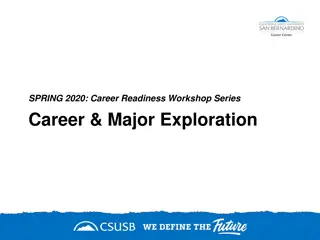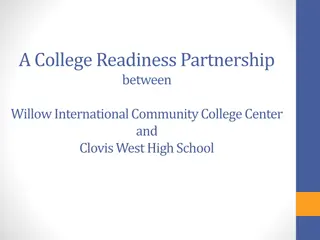The Urgency of Middle School for College and Career Readiness
Middle school is a critical time for preparing students for college and career success, as research shows that academic achievement in 8th grade significantly impacts readiness upon high school graduation. Key factors like basic skills teaching, risk factors for dropout, and best practices for middle schools are highlighted to emphasize the importance of focusing on the middle grades. The goal is to ensure students reach specific benchmarks by 9th grade to be prepared for further academic and career paths.
Download Presentation

Please find below an Image/Link to download the presentation.
The content on the website is provided AS IS for your information and personal use only. It may not be sold, licensed, or shared on other websites without obtaining consent from the author.If you encounter any issues during the download, it is possible that the publisher has removed the file from their server.
You are allowed to download the files provided on this website for personal or commercial use, subject to the condition that they are used lawfully. All files are the property of their respective owners.
The content on the website is provided AS IS for your information and personal use only. It may not be sold, licensed, or shared on other websites without obtaining consent from the author.
E N D
Presentation Transcript
MONTANA GEAR UP THE URGENCY OF MIDDLE SCHOOL What does the research show?
5) I agree 100% 4) I mostly agree 3) That s somewhat true 2) I somewhat disagree 1) I disagree
POINTS FOR DISCUSSION: my question startling quotes why middle school? 3 risk factors for dropout 4 key recommendations 4 best practices for middle schools contact presenter resources
OBSERVATIONS IT STARTED WITH A GUT FEELING There are basic skills we can/should be teaching students to help them succeed academically. Services should follow a logical sequence or age progression. Students need different supports at different points in time. If a student cannot read well or do math, the campus visit will not matter.
STARTLING WORDS ... the level of academic achievement that students attain by 8th grade has a larger impact on their college and career readiness by the time they graduate high school than anything that happens academically in high school ." THE FORGOTTEN MIDDLE: ENSURING THAT ALL STUDENTS ARE ON TARGET FOR COLLEGE AND CAREER READINESS BEFORE HIGH SCHOOL. 2008 ACT
https://nces.ed.gov/programs/coe/indicator/cnc https://nces.ed.gov/programs/coe/pdf/coe_cnb.pdf
MORE STARTLING WORDS Increasing graduation rates and producing college-and-career- ready graduates cannot be accomplished without greater focus on the middle grades." IMPROVED MIDDLE GRADES SCHOOLS FOR IMPROVED HIGH SCHOOL READINESS: 10 BEST PRACTICES IN THE MIDDLE GRADES. SREB 2012
Why is Middle School an Urgent Time for College & Career Readiness?
WHY BY 9TH GRADE? SPECIFIC H.S. BENCHMARKS Algebra 1 by end of 9th grade or earlier- to be ready for college math without remediation On track with required credits for entering college Able to take Dual Enrollment and pass Able to choose classes that align with career interests Improved Middle School Grades for Improved High School Readiness: Ten Best Practices, SREB 2012
3 Middle School Strategies 1. Identify at-risk students early. 2. Discuss the transition early. 3. Connect with families. ***Hanover Research, 2017 Supporting Successful High School Transitions
Identify Early ABSENCES BEHAVIOR COURSE GRADES Excused/Unexcused Referrals/Suspensions Math/English ***Hanover Research, 2017 Supporting Successful High School Transitions
Policies Checklists Academies No Zeros Phone Calls
Summer Bridge Programs Mitigate summer learning loss Provide opportunity to catch-up Prepare for the transition to High School ***Hanover Research, 2017 Supporting Successful High School Transitions
High School Strategies Monitor the ABC's Advising Small learning communities Catch up courses ***Hanover Research, 2017 Supporting Successful High School Transitions
What can middle schools do to become more effective in preparing students for HS?
WHAT ARE BEST PRACTICES FOR IMPROVING HS READINESS? KEY BEST PRACTICES 1. A clear mission for knowledge & Skills that students leave 8th grade with 2. Professional development for staff 3. Focus on reading & writing across the curriculum 4. High quality advising and guidance Improved Middle School Grades for Improved High School Readiness: Ten Best Practices, SREB 2012
4 Key Recommendations INTERVENE EARLY INTENSIVE, INDIVIDUAL SUPPORT CONNECT TO REAL LIFE CREATE SMALL COMMUNITIES Monitor all students using data, to track the ABCs and proactively intervene using things like double dose math, positive behavior interventions, etc. Curricula should connect content to college and career success. Curricula can be used to help student develop skills to handle life's challenges. For very large schools, where there are many at risk, create smaller communities, for students to work with and receive support from the same teachers. For students who have fallen off track, and not responded to interventions, assign an adult advocate to help put in more support. ***Preventing Drop Out in Secondary Schools, US Department of Education, Educator's Practice Guide, What Works Clearing House 2017
high quality advising tracking ABC s SEL help choosing classes 9th Grade Academy no zero policy assign an advocate to students most at-risk tutoring problem solving skills summer bridge programs talk to parents about learning gaps Content tied to careers 21 hours of double dose classes project-based learning professional real world application of lesson content Increase student development in study skills engagement 3 years
KEY TAKEAWAYS USE CONTENT ONE CARING ONE CARING ADULT ADULT TEACHERS TEACHERS NEED: NEED: ABC s ABC s CONNECT CONTENT SEL can be SEL can be incorporated incorporated into lessons and conversations, to teach coping skills, social skills, problem solving, empathy One caring adult assigned to a student, who believes in the student, can make the difference Teachers need time to plan together; time time to discuss student needs, time to strategize, time for training time Help students see how their work how their work applies in a career applies in a career setting or college setting or college program Strongest Indicators for Dropout: Absences, Behaviors, Course Completion time time
MAILING ADDRESS 560 N Park Ave, Fourth Floor Helena, Montana 59601 REACH OUT EMAIL ADDRESS kwilson@montana.edu PHONE NUMBER 406-449-9144
The Critical 9th Grade Year: More on Student Success, Practical Leadership, 2013, https://oregongearup.org/sites/oregongearup.org/files/research-briefs/ninthgrade.pdf The Impressive Effects of Tutoring on PreK-12 learning: A Systematic Review of Meta- Analysis of the Experimental Evidence, Andre Nikow, Phillip Oreopoulos, and Vincent Quan, NBER Working Paper No. 27476 2020. https://www.nber.org/system/files/working_papers/w27476/w27476.pdf Improved Middle Grades Schools for Improved High School readiness: Ten best Practices in the Middle Grades, SREB, 2012, https://www.sreb.org/sites/main/files/file- attachments/12v05_middlegrades_10_best_practices.pdf?1459975946 Ninth Grade Counts; Strengthening the Transition into High School, Stephen E Abbott and Pamela D Fisher., 2012, DOE Resource, https://www.greatschoolspartnership.org/resources/ninth-grade-counts/ Preventing Drop Out in Secondary Schools, US Department of Education, Educator's Practice Guide, What Works Clearing House 2017, https://ies.ed.gov/ncee/wwc/docs/practiceguide/wwc_dropout_092617.pdf Redefining Readiness, https://www.redefiningready.org/toolkit then click on Redefining Ready! Summary Booklet Rural Dropout Prevention Issue and Solutions, Hobart Harmon PhD, Jay Smink, DEd, 2017, National Dropout Prevention Center, https://dropoutprevention.org/rural-dropout- prevention-resources/ Supporting Successful High School transitions. Hanover Research, 2017 (covers middle school, summer bridge programs, and high school) https://www.hanoverresearch.com/reports-and- briefs/supporting-successful-high-school-transitions/ Resources For further learning:
